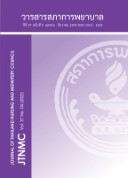Factors Predicting the Quality of Life of Residents North of Sirikit Dam’s Reservoir
Keywords:
social suppor, access to healthcare, health-promoting behaviours, age, quality of life, residents north of Sirikit Dam’s reservoirAbstract
Objective: To investigate factors predicting the quality of life of people living in the area north of Sirikit Dam’s reservoir in Uttaradit Province
Design: Predictive correlational research
Methodology: The subjects, recruited via simple random sampling, were 231 males and females aged 20 and above who had lived in the area north of Sirikit Dam’s reservoir for at least 6 months. Data were collected between April and May 2021, using a set of questionnaires on: 1) personal information; 2) access to healthcare; 3) health-promoting behaviours; 4) social support; and 5) quality of life. The data were analysed using commercial descriptive statistics software, in terms of percentage, mean, and standard deviation. Correlational analysis was performed using Pearson’s correlation coefficient and the stepwise multiple regression method.
Results: The subjects’ overall quality of life was at a moderate level (X = 91.72, SD = 10.66). The factors of social support (β = .268, p < .01), access to healthcare (β = .211, p < .01), health-promoting behaviours (β = .303, p < .01), and age (β = -.141, p = .01) were identified as being capable of jointly predicting the subjects’ quality of life by 33.6%.
Recommendations: It is recommended that local administrators and any party responsible for enhancing the quality of life of the residents north of Sirikit Dam’s reservoir set a policy to organise health-promoting activities, promote access to healthcare, and seek community-based assistance, to empower these residents to have better and more sustainable quality of life.
Downloads
References
World Health Organization. Division of mental health and prevention of substance abuse. Program on mental health: WHOQOL user manual [Internet]. 2012 [cited 2022 Feb 12]. Available from: https://www.who.int/tools/whoqol.
Trevittaya P. Concepts of quality of life. Journal of Associated Medical Sciences. 2016;49(2):171-84. (in Thai)
Ministry of Interior. Community development department. The report of quality of life Thailand people from basic minimum needs 2021 [Internet]. [cited 2022 Jan 23]. Available from:https://rdic.ccd.go.th/bmn-service (in Thai)
Office of the Prime Minister. Office of the National Economic and Social Development Council. The twelfth national economic and social development plan (2017-2021) [Internet]. 2017[cited 2022 Feb 12]. Available from: https://www.nesdc.go.th (in Thai)
Ministry of Interior. Department of Provincial Administration. Official statistics registration systems [Internet]. 2013 [cited 2022 Feb 12]. Available from: https://stat.bora.dopa.go.th/stat/statnew/statMenu/newStat/home.php (in Thai)
Mahatnirunkul S, Tantipiwatthanakul W, Pumpaisalchai W, Wongsuwan K, Pornmanajirangul R. Comparison of the WHOQOL-100 and 26 scale. Chiang Mai: Suanprung Psychiatric Hospital; 1997. (in Thai)
Akinyemi OO, Owoaje ET, Popoola OA, Ilesanmi OS. Quality of life and associated factors among adults in a community in South west Nigeria. Ann Ib Postgrad Med. 2012;10(2):34-9.
Noknoi C, Boripunt W. The quality of life of elders in Songkhla province. Princess of Naradhiwas University Journal. 2017;9(3):94-105. (in Thai)
Gattino S, Piccoli ND, Fassio O, Rollero C. Quality of life and sense of community. A study on health and place of residence. J community Psychology. 2013;41(7):811-26.
Tasuwanin T, Maneerat W, Rappakit K, Laorinthong A, Winyangkul P. Quality of life of the elderly ethnic in Chiang Rai province. Journal of Nursing and Health Care. 2018;36(4):74-82. (in Thai)
Green L, Kreuter M. Health program planning: an educational and ecological Approach. 4th ed. New York: McGraw-Hill; 2005.
Daniel WW. Biostatistics: a foundation for analysis in the health sciences. 10th ed. Las Vegas: Edwards Brothers Molloy; 2013.
Wong FY, Yang L, Yuen JWM, Chang KKP, Wong FKY. Assessing quality of life using WHOQOL-BREF: a cross-sectional study on the association between quality of life and neighborhood environmental satisfaction, and the mediating effect of health-related behaviors. BMC Public Health. 2018;18(1):1113.
Hinkhaw C, Leaungsomnapa Y, Pattamasutthikun N, Srithahai J, Khanviset S, Pootthai P. Quality of life of people with chronic illness in the responsible areas of Tha Chang Sub-district administrative organization, Chanthaburi province. Journal of Health Science Research. 2017;11(1):23-32. (in Thai)
Kaewkungwal J, Singhasivanon P. Textbook of clinical research. Bangkok: Amarin printing and Publishing; 2011. (in Thai) 1
Seeherunwong A, Suwonnaroop N. An analysis of validity and reliability of the health-promoting lifestyle profile-II in Thai version. Journal of Thailand Nursing and Midwifery Council. 2004;19(4):44-63. (in Thai)
Best JW. Research in education. New Jersey: Prentice Hall; 1981.
Penchansky R, Thomas W. The concept of access: definition and relationship to consumer satisfaction. Medical Care. 1981;19(2):127-40.
Chai-aree C. The relationship between social support, self-care behavior and quality of life in patient with congestive heart failure [Dissertation]. Nakhon Pathom: Mahidol University; 1990. (in Thai)
Munro BH. Statistical methods for health care research. 5th ed.Philadelphia: Lippincott Williams & Wilkins; 2005.
Wangthong A, Wangthong A, Luemoh A, Sangpum M. The quality of life of the population in Nongjik district, Pattani province. The Journal of Primary Care and Family Medicine. 2019;2(2):50-7. (in Thai)
Rizal H, Said MA, Abdul MH, Su TT, Maw PT, Ismail R, et al. Health-related quality of life of younger and older lower-income households in Malaysia. journal.pone. 2022;17(2):1-15.
Supahatthee S. Factors affecting quality of life of the elderly in Ban Nongpednam, Tambon Kokkruad, Amphoe Mueang, Nakhonratchasima. Journal of Nakhonratchasima College. 2011;5(2):11-5. (in Thai)
Office of the Prime Minister. Office of the national economic and social development council. poverty and inequity report [Internet]. 2019 [cite 2022 Feb 12]. Available from: http://social.nesdc.go.th (in Thai)
Ratana-Ubol A. Am analysis and synthesis of philosophies, concepts, and principles of lifelong education for becoming a learning community. Journal of Education Studies. 2019;47(2):428-44. (in Thai)
Downloads
Published
How to Cite
Issue
Section
License
Copyright (c) 2022 Thai Journal of Nursing Council

This work is licensed under a Creative Commons Attribution-NonCommercial-NoDerivatives 4.0 International License.








